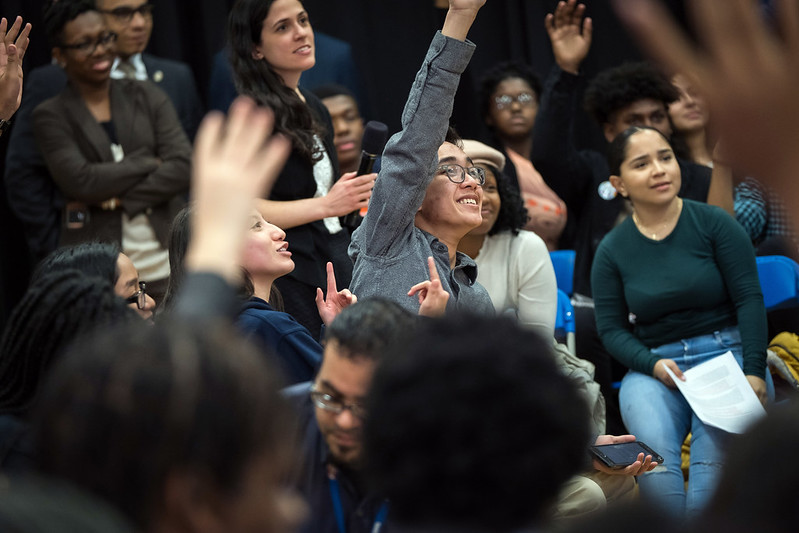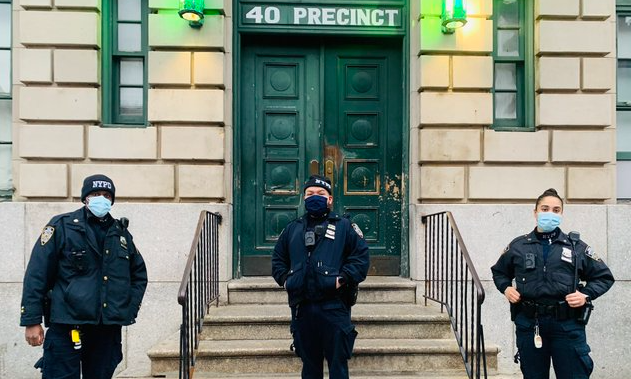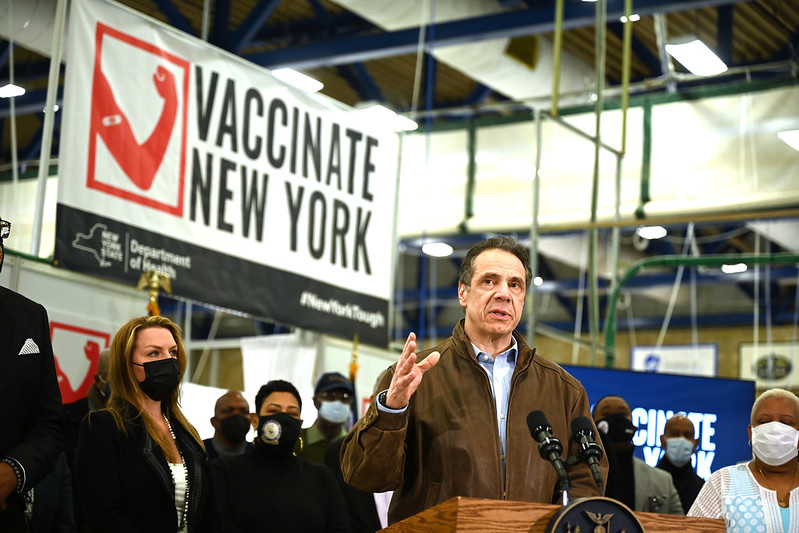New York’s Chance to Pass Essential Sex Education Mandates

Students (photo: Ed Reed/Mayor's Office)
Like many states, New York’s sex education laws are dizzyingly complicated. Sex education itself is not mandated in New York public schools (though many school districts choose to teach it), but HIV/AIDs education is — though parents can opt their children out with the promise that they will teach the content at home. If sex education does take place, New York state law requires that it stresses abstinence, but makes no legal requirement concerning its medical accuracy. Some individual school districts, like New York City, do mandate a comprehensive sexuality education (CSE) curriculum, while others have no such requirement.
Democratic State Senator Samra Brouk’s bill (S2584) would simplify some of this tangled mess by making comprehensive sexuality education mandatory for all K-12 New York State public and charter school students, and it should be passed by both houses of the Legislature and signed by the Governor as soon as possible.
CSE is endorsed by the American Medical Association, the American College of Obstetricians and Gynecologists, the Society for Adolescent Health and Medicine, the American Public Health Association, and others. And with its dedication to being “age-appropriate, medically accurate, and inclusive of all students,” CSE should be the bare minimum of what we ask of sex education in schools, and Brouk’s bill should be a no-brainer.
But if history is any guide, there is no guarantee that our young people will be given what they are owed. New York’s 2020 legislative year saw six very similar bills to Bourk’s, all of which failed.
Despite widespread support from medical, public health, and education experts, opposition to CSE is fierce in New York and nationwide. The Catholic Church and other conservative Christian denominations came out against a bill nearly identical to Bourk’s in 2019, and will almost certainly line up to do so against this one, and right-wing media is already at work misrepresenting the project.
“Get ready for the latest woke wave in education,” The New York Post began in an article about the bill. The Christian Post proclaimed: “NY bill could force schools to teach sex ed to kindergarteners, gender identity to 2nd graders.”
Both of these stances misrepresent the project of CSE. First, the implication that comprehensive sex education is new is false. Sex education in some form, for students of all ages (including kindergarteners), has been in the United States since at least 1913, and “comprehensive sex education” is a term that has been in use since at least 1981, if not earlier.
And while the term “sex ed” as levied in these articles tends to bring to mind a condom and a banana, in reality, CSE encompasses a whole range of things that most of us don’t think of as falling squarely into the category.
SIECUS, a comprehensive sexuality education advocacy group founded in 1964, publishes guidelines for CSE that would probably be used to develop New York curricula if Brouk’s bill passes. SIECUS outlines six “key concepts” involved in CSE: human development, relationships, personal skills, sexual behavior, sexual health, and society and culture.
SIECUS’ recommendations for the youngest grades are relatively tame, and mostly have to do with families, friendship, body parts, and feelings. Most of its focus is on teaching children that their bodies belong to themselves, a measure that works to reduce instances of childhood sexual abuse.
The frank discussion about masturbation, sexually transmitted infections, and HIV/AIDS for the younger grades, and the information about contraception, abortion, and gender identity for older ones may make some squeamish — but truthful answers, words, and names are better than the alternative.
And the alternative to CSE rarely is no sex education at all. While some school districts may choose to forego the subject entirely, often schools choose instead to employ an abstinence-only-until-marriage (AOUM) curricula, which has now been rebranded as “sexual risk avoidance education” (SRAE).
AOUM/SRAE curricula are marked by their refusal to instruct about (and sometimes even discuss) contraception, and have traditionally and consistently been homophobic, racist, tinged with a Christian bias, and can be medically inaccurate — all of which CSE classes correct for.
The reprehensible biases and misinformation in these curricula are enough to call for their immediate disuse, but the data also suggests that AOUM/SRAE classes just don’t work in any measurable way. CSE has a number of goals, some more quantifiable than others. But one of the markers of a successful sex education curriculum should certainly be its efficacy in preventing pregnancy and sexually transmitted infections — and on that score, AOUM/SRAE are demonstrably less effective than CSE.
And preventing STIs and pregnancy should be a priority everywhere, including New York. As of 2018, New York had the 10th highest rate in the nation for both chlamydia and syphilis, and 54% of all STIs were diagnosed in people under the age of 26. And though New York does relatively well nationally in terms of teen pregnancy, the United States has one of the highest teen birth rates in the developed world.
These are high-stakes issues: real-world problems screaming for real-world, data-driven solutions. CSE is one of those solutions, and we shouldn’t let willful misinformation about it cloud our perceptions or actions any longer.
***
Margaret Grace Myers is a Brooklyn-based writer. On Twitter @margaretgmyers.
New York’s Rape Laws Must Be Updated To Protect LGBTQ Survivors

NYPD (photo: @NYPDnews)
In December, a group of models and influencers at Fashion Week publicly accused designer Alexander Wang of drugging and sexually assaulting them. The victims all painted the same picture: Wang would allegedly ply them with alcohol or lace a water bottle with MDMA, and then forcibly touch them, make them perform oral sex, or sodomize them while incapacitated. Many of the acts happened here in Manhattan at the popular bar Bedlam on Avenue C and at Wang’s West Chelsea apartment.
But the story has mostly flown under the radar. Why?
Because socially and legally, we downgrade sexual violence against men and transpeople.
Under the law, none of Wang’s alleged victims were technically “raped.” New York only recognizes this most serious crime as between a cis man and a cis woman. At most, the alleged attacks constitute criminal sexual acts. Rape is defined as only vaginal penetration and treats oral and anal sexual conduct as separate crimes. The rape statute is a relic of the Model Penal Code, drafted in 1962, seven years before the Stonewall riots and almost 50 years before many of the enumerated rights of the LGBTQ community. It relies on an outdated notion of sex suggesting queer people are deviant and transpeople do not even exist.
The social implications of 1962 live on. Reporting among men is incredibly low, less than 10% of reported rapes according to the National Sexual Violence Resource Center. When men do report they’re often met with skepticism. HBO’s I May Destroy You most recently dealt with this reality in an excruciating episode where a gay character tries to report being raped after first having consensual, anonymous sex with a man he met on Grindr. He’s doubly victimized by the police officer who shames him for not knowing his attacker’s name, and blames him for using a dating app.
Albany lawmakers can take an axe to the ingrained homophobia still baked into our laws by passing the "Rape is Rape" bill now. The legislation would remove the penetration requirement and define rape as either vaginal, anal, or oral “contact.”
Seems like a no-brainer, but the male dominated District Attorneys’ Association of New York State opposes it. When current Manhattan District Attorney Cy Vance headed up the association in 2013, he wrote a letter claiming the bill would “create an insurmountable hindrance to consecutive sentencing.” That’s just a technical pretext though, which is neither insurmountable nor a hindrance. The fact is the bill would allow prosecutors across New York to hold rapists accountable for rape no matter who the survivor is.
If politicians are willing to chant “love is love” then we should demand they declare rape is rape too.
***
Diana Florence is a Democratic candidate for Manhattan District Attorney. On Twitter @DianaJFlorence.
***
Have an op-ed idea or submission for Gotham Gazette? Email This email address is being protected from spambots. You need JavaScript enabled to view it.
This article has been corrected to accurately reflect classifications under the current law.
Is Cuomo Letting Scandals Get the Best of His Pandemic Judgement? What the Governor Must Do to End Covid in New York

Gov. Cuomo (photo: Kevin P. Coughlin/Governor's Office)
Governor Cuomo seems to be letting his political scandals get the best of his judgement. Last Thursday, he announced sports stadiums and outdoor concerts can resume on a limited basis in April, even as New York State books more than 6,700 new cases each day. That is 6,000 more cases per day than we were registering at our lowest point last summer. Combined with his decision to increase indoor dining capacity, the governor’s move simply invites the virus and all its variants to infect more New Yorkers before the vaccine reaches enough people.
Despite all the talk of optimism, the situation remains serious and concerning. With new more-contagious variants spreading, the risk of another wave of infections exponentially rises each time we allow more people to gather. Even if people are vaccinated and tested at the door of stadiums and concerts, the virus can still spread, especially if new variants emerge that are less detectable or resistant to the vaccine. Our likely long-term endgame in that scenario – the one we need to avoid – is an endemic virus that mutates chased by vaccines that statistically reduce but do not eliminate the pandemic.
Governor Cuomo’s decisions, taken together with disastrous moves by Governors Desantis in Florida and Abbott in Texas, underscore why the United States always seems to be one step behind COVID-19 - cycling through a Groundhog Day-like pattern of opening, closing, and reopening again. Lawmakers impose restrictions when hospitalizations and infections rise. They lift those restrictions when metrics fall. Then - having allowed another crisis to mount - they’re forced to put those same restrictions back in place. This is unacceptable, and it doesn’t have to be this way.
By contrast, places like Australia, New Zealand, Vietnam, and Atlantic Canada have all returned to a sense of normalcy, mostly because they began taking aggressive steps before infections and hospitalizations got so far out of control.
Australia, for instance, has confined outbreaks by restricting inter-state travel among its eight states. In some cases, such as Melbourne in September and Sydney in December, travel restrictions were imposed within a city. This has at times been difficult for the 25 million Australians. But today, as the United States infection rate remains stubbornly high, Australia’s daily new case count is miniscule, averaging less than 11 new cases in the last week.
For the U.S. to change course for the better, we need to reset and choose to resemble Australia’s approach. That means doubling down on actions that stop community spread for a short period of time, providing space for vaccines to take hold and then re-opening in a targeted fashion.
The concept is simple: endure five weeks of stay-at-home orders now to save lives and put us in a position to reopen our economy as soon as possible. It means allowing only minimal essential services and mandating transmission prevention protocols like delivery, curbside pickup, mask wearing, air purification, and disinfection. It also means rigorous travel restrictions and 14-day traveler quarantines to prevent COVID-19 from crossing borders. The smaller the area, the faster the process of getting to zero. Testing, vaccinations, and mask-wearing remain critical, but they should not be the sole emphasis.
After one month of these measures, some areas will have eliminated community transmission. Those can be labeled green zones and begin reopening their economies. All other areas are labeled red. Travel between red and green zones should be limited. Week after week, more green zones will emerge, and travel can begin across a green zone travel network. Our model predicts that after six weeks, participating states could end community transmission of COVID-19.
I know there is a political desire to start making people feel good about gathering in large number s again. But neither politics nor wishful thinking should drive our pandemic decisions. It is this mentality that has dug us into a hell of our own creation. The only way we beat the virus is by using vaccinating and simultaneously imposing stay-at-home orders and travel restrictions to end transmission and stop variants from emerging. This is the fastest route back to normal. If New York does it, the rest of the world will follow.
***
Dr. Yaneer Bar-Yam is the founding president of the New England Complex Systems Institute, where he is an expert on pandemics and other complex systems. He is spearheading the effort of over 3,000 volunteers working to stop the outbreak at endcoronavirus.org. On Twitter at @yaneerbaryam.
***
Have an op-ed idea or submission for Gotham Gazette? Email This email address is being protected from spambots. You need JavaScript enabled to view it.




